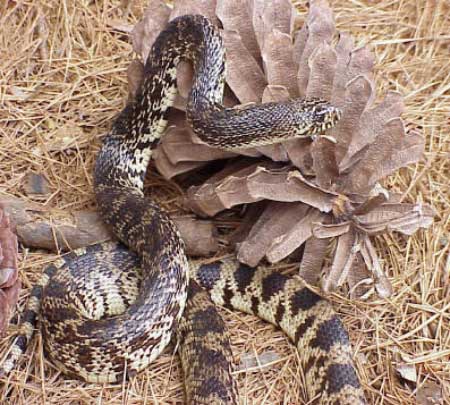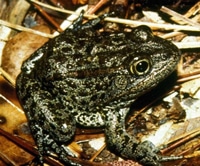Wildlife and Fisheries Commission also proposes permit system for taking or killing Eastern Diamondback rattler and two species of pine snake.
The Louisiana state Wildlife and Fisheries Commission has proposed that the Mississippi gopher frog (Rana capito sevosa ) be added to the state's endangered list and that permits be required to kill or remove the eastern diamondback rattlesnake (Crotalus adamanteus), Louisiana pine snake (Pituophis ruthveni), and the black pine snake (Pituophis melanoleucus lodingi) from the wild. Scientists who are studying the animals may capture, take measurements and tissue samples (by means that are acceptable by the Department of Wildlife and Fisheries), and immediately release the animals on site would not need a permit.
The Advertiser reports that the state's scientists do not know of any populations of Mississippi gopher frog living in Louisiana, although they were once found in the state and that the frog is on the federal Endangered Species list. The U.S. Fish and Wildlife Service designated in June 2012 1,600 acres of private land in St. Tammany Parish, Louisiana as critical habitat to the frog. This area includes the frog's last known breeding pond in Mississippi. The owner of the land is still fighting that designation, the report said.
The black pine snake has all but vanished in the state. According to the U.S. Fish and Wildlife Service, the only known populations in the country can be found in three counties in Alabama and 10 counties in Mississippi.

Photo by Daniel Saenz.
Louisiana pine snake (Pituophis ruthveni) The last documented sighting of this species of snake in the wild was more than 10 years ago.
The Louisiana pine snake has been found in the past in four parishes in Louisiana and five counties in Texas. Three Louisiana pine snakes were released into Louisiana's Kisatchie National Forest in May 2012. These three joined 27 other pine snakes that have been released in the area over the past several years. The last documented sighting of this species of snake in the wild was more than 10 years ago.
The eastern diamondback rattlesnake has seen its populations decimated by so-called rattlesnake roundups, whereby rattlesnakes are captured by the hundreds and killed during these roundups. Currently the state doesn't have a bag limit on the eastern diamondback rattlesnake and the USFWS is studying whether to list the species as endangered.
Currently the state has seven reptiles on its endangered list; the gopher tortoise (Gopherus polyphemus), all five sea turtles (green sea turtle, Chelonia mydas; Hawksbill sea turtle, Eretmochelys imbricata; Kemp's Ridley sea turtle, Lepidochelys kempii; leatherback sea turtle, Dermochelys coriacea; and the loggerhead sea turtle, Caretta caretta) that inhabit the state's waters, and the ringed sawback turtle (Graptemys oculifera). The Mississippi gopher frog, if approved, would be the first amphibian on the endangered list. The two pine snakes and the eastern diamondback rattlesnake would join five types of salamander (tiger salamander, Ambystoma tigrinum; southern red-backed salamander, Plethodon serratus; Webster's salamander, Plethodon websteri; and mud salamander, Pseudotriton montanus), that are on the restricted list and require a permit to kill or remove from the wild.
Those interested can make public comments on the proposed rule at a meeting on Feb. 7, and comments by mail will be accepted through Feb. 20. Comments can be mailed to Mr. Robert Love, Coastal Natural Resources Division, Department of Wildlife and Fisheries, Box 98000, Baton Rouge, LA, 70898-9000. For meeting information, visit the Louisiana Wildlife and Fisheries Commission website.


